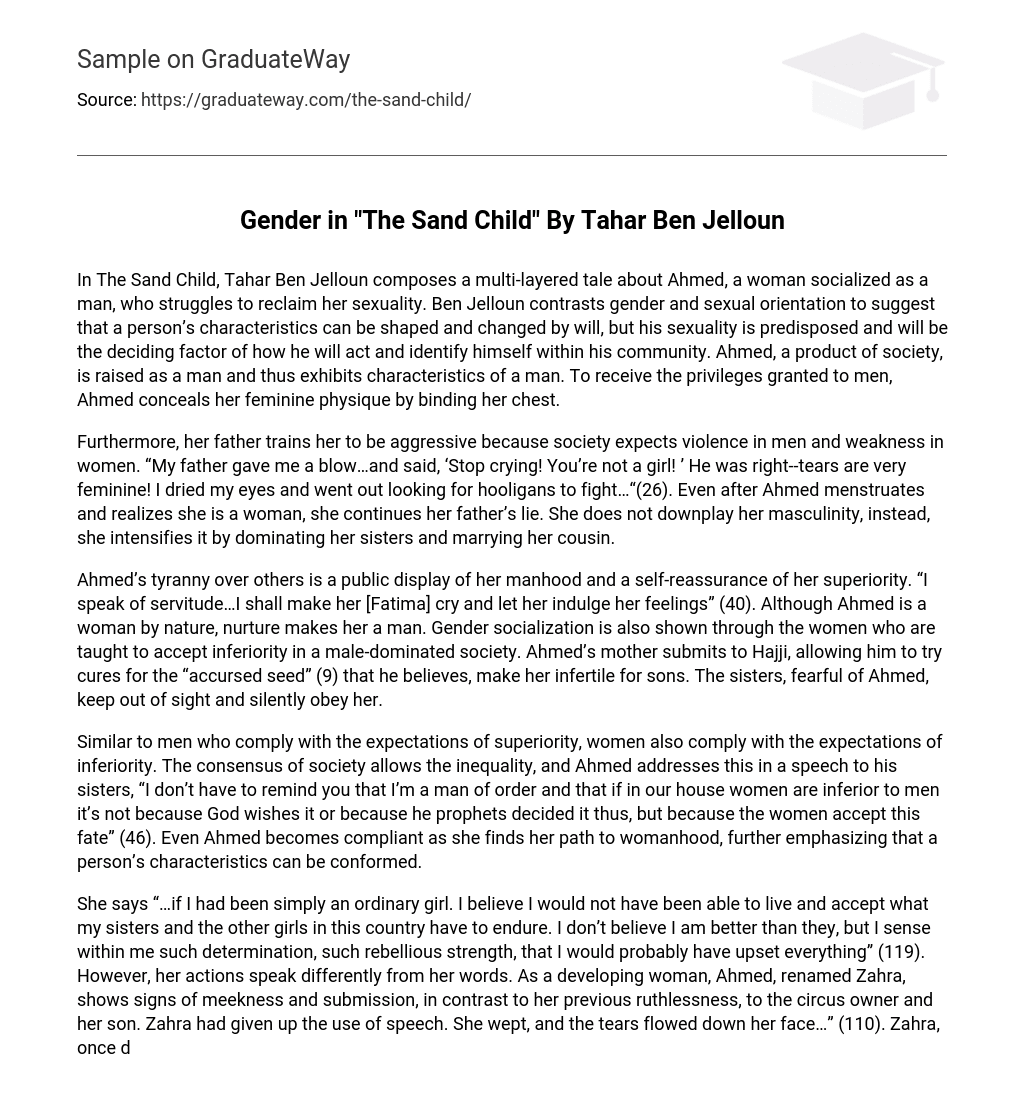In The Sand Child, Tahar Ben Jelloun composes a multi-layered tale about Ahmed, a woman socialized as a man, who struggles to reclaim her sexuality. Ben Jelloun contrasts gender and sexual orientation to suggest that a person’s characteristics can be shaped and changed by will, but his sexuality is predisposed and will be the deciding factor of how he will act and identify himself within his community. Ahmed, a product of society, is raised as a man and thus exhibits characteristics of a man. To receive the privileges granted to men, Ahmed conceals her feminine physique by binding her chest.
Furthermore, her father trains her to be aggressive because society expects violence in men and weakness in women. “My father gave me a blow…and said, ‘Stop crying! You’re not a girl! ’ He was right–tears are very feminine! I dried my eyes and went out looking for hooligans to fight…“(26). Even after Ahmed menstruates and realizes she is a woman, she continues her father’s lie. She does not downplay her masculinity, instead, she intensifies it by dominating her sisters and marrying her cousin.
Ahmed’s tyranny over others is a public display of her manhood and a self-reassurance of her superiority. “I speak of servitude…I shall make her [Fatima] cry and let her indulge her feelings” (40). Although Ahmed is a woman by nature, nurture makes her a man. Gender socialization is also shown through the women who are taught to accept inferiority in a male-dominated society. Ahmed’s mother submits to Hajji, allowing him to try cures for the “accursed seed” (9) that he believes, make her infertile for sons. The sisters, fearful of Ahmed, keep out of sight and silently obey her.
Similar to men who comply with the expectations of superiority, women also comply with the expectations of inferiority. The consensus of society allows the inequality, and Ahmed addresses this in a speech to his sisters, “I don’t have to remind you that I’m a man of order and that if in our house women are inferior to men it’s not because God wishes it or because he prophets decided it thus, but because the women accept this fate” (46). Even Ahmed becomes compliant as she finds her path to womanhood, further emphasizing that a person’s characteristics can be conformed.
She says “…if I had been simply an ordinary girl. I believe I would not have been able to live and accept what my sisters and the other girls in this country have to endure. I don’t believe I am better than they, but I sense within me such determination, such rebellious strength, that I would probably have upset everything” (119). However, her actions speak differently from her words. As a developing woman, Ahmed, renamed Zahra, shows signs of meekness and submission, in contrast to her previous ruthlessness, to the circus owner and her son. Zahra had given up the use of speech. She wept, and the tears flowed down her face…” (110). Zahra, once domineering, is now compliant. Ahmed alters her personality because she, as well as the Islamic society, associates womanhood with obedience. Although Ahmed is socialized as a man, her innate sexuality drives her to reclaim her womanhood. As a child viewed by society as a boy, Ahmed shows no interest in the daily lives of women. In the hammam with her mother, Ahmed says, “I would get bored, but I had no choice.
In fact, I would have preferred to go to the baths with my father. He always bathed very quickly and spared me all that interminable ceremonial” (22). Ahmed shows no desire to associate with women until after she marries Fatima. Fatima does not sexually arouse Ahmed, yet she is curious about Fatima’s body. “One day, as she [Fatima] lay asleep, I tried to see if she had been circumcised or if the lips of her vagina had been sewed up” (56). After the death of Fatima, Ahmed’s sexual desires are unleashed first in the form of dreams, then through self-gratification.
Suddenly, Ahmed is aware of her physique, searching for the feminine qualities of her frame. “My breasts are so small. Only my buttocks have anything feminine about them” (73). Ahmed finally unbinds her chest, symbolizing her readiness to free the woman trapped under the guise of a man. Her biological predisposition causes her to change her lifestyle, disposing of the years she lived as a man. Tahar Ben Jelloun uses instances of homosexuality to emphasize, furthermore, that sexual preference is inborn and transcends gender expectations.
In the men‘s hammam, Ahmed observes, “I later learned that in those dark corners the masseurs did other things than massage, that encounters and reunions took place there, and that the silence was not innocent” (25). Ben Jelloun is hinting at privates scenes of homosexuality despite Islamic laws that forbade it. Homosexuality is also prominent between the women in the novel. Ahmed participates in scenes with erotic inferences, such as the old beggar woman who molests Ahmed, to Ahmed‘s enjoyment. Then there is the circus owner who gets pleasure out of bathing Ahmed. “The old woman insisted on washing Zahra [Ahmed] once a week.
As she was pouring water over Zahra’s body, she stroked her, felt her vagina…”(110). Although homosexuality does not always align with gender expectations, it occurs nevertheless, because sexual preference is a predisposition that cannot be altered. Gender is created through society’s discretion, as shown through the expectations given to both the men and women in The Sand Child. A person’s characteristics is the result of nurture. However, sexuality is the result of nature, and thus, cannot be controlled. Tahar Ben Jelloun suggests that ultimately, people’s actions will follow what nature intended.





